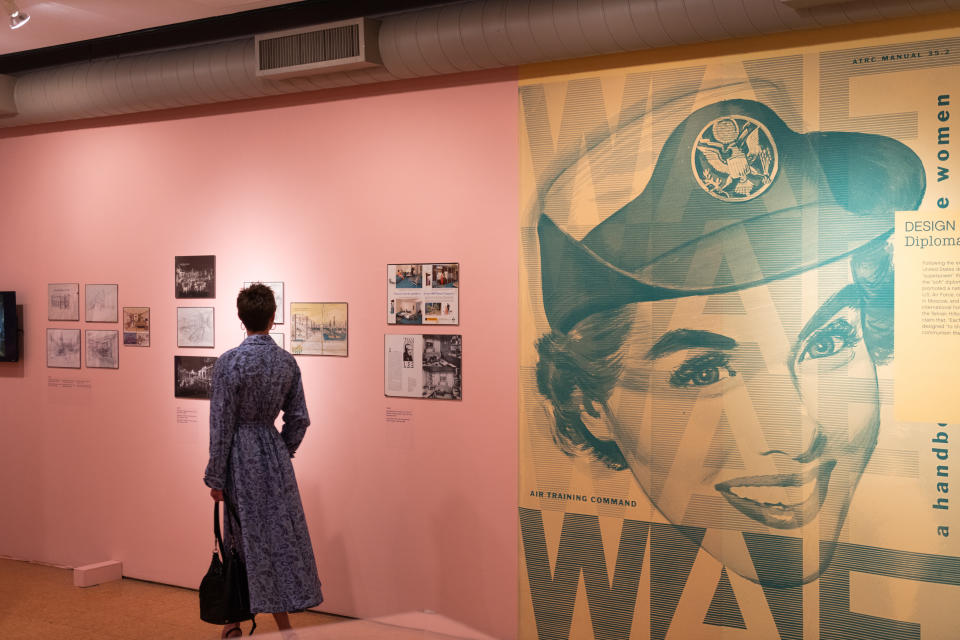Design Lessons to Be Learned From Tom and Sarah Tomerlin Lee

Multihyphenate monikers are now very much a thing with influencers and wannabes alike. But decades before interdisciplinary design became such a self-defining salary track, the husband-and-wife team of Tom Lee and Sarah Tomerlin Lee exercised their design dexterity working at department stores, in interiors, theater, magazine publishing and architecture.
Their largely unheralded professional lives are the focus of a new exhibition at the New York School of Interior Design, and is also accessible online. On view until Dec. 5, “Designing Duo: Tom Lee and Sarah Tomerlin Lee” draws from the couple’s archives, which have been donated to the Upper East Side academic institution.
More from WWD
Building an archive of interior designers’ work was part of the impetus for the exhibition, according to Donald Albrecht, who co-curated the show with Thomas Mellins. “And like in all of life these days, there’s a desire to broaden the beaten path of the typical white, male-dominant designer,” he said.
Tomerlin Lee was largely known in her day for renovating the Helmsley Palace Hotel in New York and the Willard in Washington, D.C., and serving as editor of House Beautiful, but she has been largely forgotten, Albrecht said. “We were interested in her husband, but she was a very dynamic and interesting woman. She worked at Vogue, Harper’s Bazaar and Lord & Taylor. Their ambidextrousness is the part that we found fascinating. It’s a real New York story — high-end retailing, fashion and decorative arts journalism, historic preservation, interiors, Broadway,” Albrecht said.
At different points in his career, Tom Lee designed sets and costumes for prized composer Irving Berlin, worked on a ballet for Lincoln Kirstein and cultivated Bonwit Teller’s reputation for theatrical store windows, including a few imagined by Salvador Dalí in 1939. After serving in the counter-intelligence branch of the U.S. Office of Strategic Services during World War II, Lee set up his own design firm in 1947, going on to design such properties as the Williamsburg Motor Lodge’s interiors and the Tehran Hilton. After his death in a car accident in 1971, his wife, who was then in her sixties, took over the design firm, going on to handle the interiors for more than 40 hotels.
Tomerlin Lee’s professional trajectory was rooted in fashion, having worked in marketing at Bonwit Teller, Margaret Hockaday’s pioneering creative agency, Lord & Taylor’s marketing department, and acting as a beauty editor at Vogue and Harper’s Bazaar well before her lead role at House Beautiful. She also served as president of the Fashion Group in the ’60s, held that same post at the Decorators Club and was founder of the New York Landmarks Conservatory. Tomerlin Lee also edited the book, “American Fashion: The Life and Times of Adrian, Mainbocher, McCardell, Norell and Trigere.” In the ’90s, when Tom Lee Ltd. became the interior design department of Beyer Blinder Belle, Tomerlin Lee headed that up from 1993 to 1997. Working well into her eighties, she died in 2001 at the age of 90.
As for what those who are new to design might glean from the Lees’ career paths, Albrecht said, “It says, ‘Be flexible.’ What Sarah used to say was she tended to move laterally. She didn’t take the boss’ job — she moved from one position to another. And she used words, narrative and storytelling. Obviously, that’s germane for fashion journalism. But when it came to doing interiors for hotels, her approach was to tell the history of a hotel and she would derive her ideas by writing them down. She would sell the idea through text more than she would through drawing, Albrecht said.

Newcomers could take heed about being flexible in manifesting a theme across different disciplines, Albrecht said.
For Tomerlin Lee, the enormous mirrored five-story atrium in the Parker Meridien Hotel in New York reflected her “fusion of the modern combined with history,” Albrecht said, adding that something about the Lees’ ethos was “optimistic, fun, glamorous, romantic and freewheeling. What’s also interesting is he was working and she was working, when modernism was king. We think of modernism being [synonymous] with Florence Knoll, Chase Manhattan Bank, the Seagram Building and [Ludwig] Mies van der Rohe. But also, there is an alternative story of modernism that is more decorative, romantic and drew on history overtly. One way that you can be modern is to look to history and update it. That’s something that people don’t realize was being done on the ’50s and ’60s.”
Best of WWD

